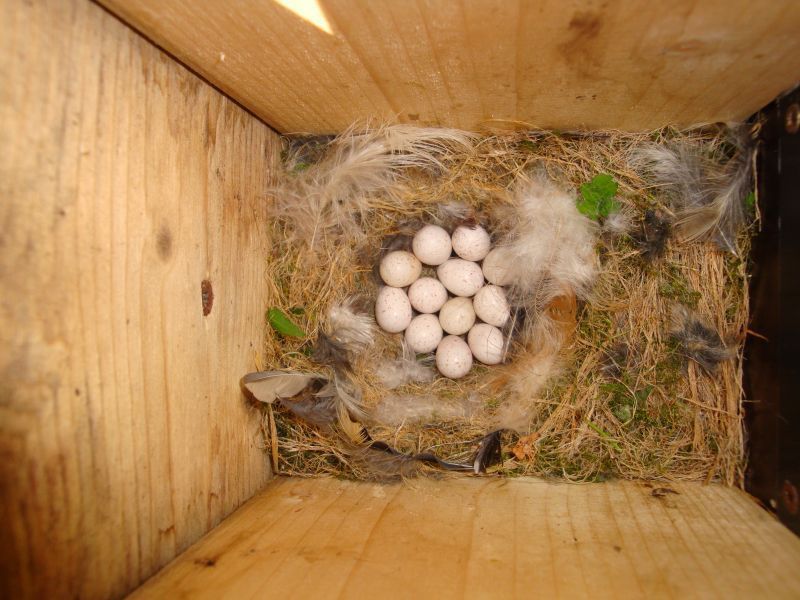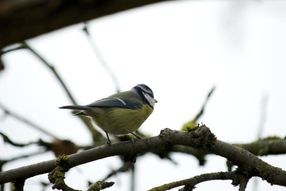The evolutionary consequences of infidelity
Can extra-pair relationships give rise to sexual dimorphism?
In the bird world, male and female blue tits are hard to distinguish for the human observer. However, in the UV-range, visible to birds, the male is much more colourful. A closer look at the monogamous mating system of these birds again reveals that all is not what it seems: in every second nest there are chicks that are not related to the care-giving father. An already mated male can increase the number of his offspring by siring extra-pair offspring in other nests than the one he cares for with his mate. Emmi Schlicht and Bart Kempenaers of the Max Planck Institute for Ornithology in Seewiesen investigated whether this could be the driving force behind the evolution of sexual dimorphism. However, their findings suggests that effects of extra-pair paternity are limited, and cuckoldry can even reduce the intensity of sexual selection.

Is the grass maybe greener on the other side? Even though blue tits raise their offspring together in socially monogamous relationships, both females and males are not averse to occasional amorous encounters with other feathered partners.
© MPI für Ornithologie

Thankfully, male blue tits don't have access to modern paternity tests: otherwise, they would discover every second nest features chicks that are not related to the care-giving father.
© MPI für Ornithologie


In many species, males and females look very different. Male deer wear impressive antlers and the magnificent plumage of a male peacock is impressive not only to the hen. In our backyard we can identify the male in chaffinches or house sparrows easily from the distinctive colouration of breast and crown. Why do these differences exist? For deer and peacock the answer is straightforward, at least in principle: a well-endowed male can better defend the females on his territory, or attract more females in the first place. For these animals sexual dimorphism has evolved, because such traits help males to obtain additional offspring. For females sexual selection is weaker as they cannot increase their number of offspring by outcompeting other females.
However, many bird species pose a challenge for this explanation by evolutionary biologists. Most bird species are socially monogamous, in permanent relationships with a partner of the other sex. Both parents have to work hard to raise their offspring. So why do males in monogamous species have more colourful plumage than females, if the number of offspring for both parents is decided by the clutch size of the female?
Paternity analyses have long revealed that not all offspring are related to the male that feeds them. Therefore, a monogamous male can have additional offspring if he succeeds in siring additional eggs in the nest of other females. Is extra-pair mating the key to sexual dimorphism?
A study on blue tits has tackled this question at its basis. Emmi Schlicht and Bart Kempenaers of the Max Planck Institute for Ornithology in Seewiesen have used data from six years of field research to examine the mating system of blue tits. The result: social relationships are the ones that count, whereas extra-pair liaisons are of advantage but do not strongly enhance sexual selection.
"Male blue tits have most of their descendants with their social partner, some of them can even form pair bonds with two females," says Bart Kempenaers, the senior author. "A few additional eggs due to an extra-pair mating cannot compete with that". Selection will thus optimize the traits of these males to secure social success and only to a lesser extent to win additional offspring with extra-pair matings.
Interestingly, the scientists found an unexpected effect of extra-pair activity. In a sibship analysis they estimated that there are up to 24 additional males per year that sire offspring, but do not breed in the nestboxes on the study site. If these unknown males really did not have an own nest, the offspring in other broods were their only descendants. That means that for these unpaired males, the offspring produced by extra-pair matings are essential. “In this case extra-pair matings actually reduce the differences between males in their reproductive success”, says Emmi Schlicht, first author of the study. “That makes a selection of "the best" less effective and hinders a fast evolution of traits in males that increase their mating success”. Infidelity can even slow evolution of sexual dimorphism.






















































